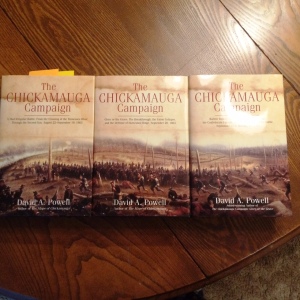It’s that time of year again…
Mission Statement: The purpose of the Chickamauga and Chattanooga National Military Park Study Group is to create a forum to bring students of the American Civil War together to study and explore those events in the fall of 1863 that led ultimately to the creation of the Chickamauga & Chattanooga National Military Park, as well as explore other nearby Civil War-related sites.
Tour Leaders: Jim Ogden and Dave Powell
Date: Friday, March 10, and Saturday, March 11, 2017; By bus and car caravan.
All tours begin and end at the Visitor’s Center.
By Bus:
Friday, 8:30 a.m. to 5:00: Battle of Resaca, May 14 – 15, 1864
On Friday we will expand our horizons to explore the nearby, brand new battlefield park at Resaca. We will move through Snake Creek Gap, and following McPherson’s Army of the Tennessee, and will subsequently examine the fighting that raged across Camp Creek Valley, the area now west of modern Interstate 75.
Friday evening, 7:30 p.m. to 9:00 p.m. – Q&A Panel with Jim Ogden, Dave Powell, and Lee White.
Site: Constitution Hall, 201 Forrest Road, Fort Oglethorpe, GA
Last year we held our first-ever free-form Q & A session. It was a success, one which we shall repeat going forward.
Car Caravan – Saturday Morning, 8:30 to Noon: Breckinridge Repulsed!
On Saturday Morning we will explore the Union counter-attacks that drove Breckinridge’s Confederate infantry out of the north end of Kelly Field, restoring the integrity of General Thomas’s Union position there, and consider the impact that action had on the rest of the Union army.
 Car Caravan – Saturday Afternoon, 1:30 p.m. to 5:00 p.m.: Breakthrough
Car Caravan – Saturday Afternoon, 1:30 p.m. to 5:00 p.m.: Breakthrough
On Saturday Afternoon we will explore the conditions that created the infamous “Fatal Order,” sent by William Starke Rosecrans to divisional commander Thomas Wood; the roles of Generals Thomas and McCook in that order, as well as examining the advance of Fulton’s Brigade, Johnson’s Confederate division through the resultant gap in the Union Right.
Costs:
Friday’s Tours will be by Bus. Pre-registration and Fee required: $45, due by February 1 2017.
Sign-up after February 1 or on-site Fee (based on space available): $50
Saturday: no charge.
Fees raised in excess of our costs (as well as any donations) will be used to support the causes of battlefield preservation, interpretation, and renovation.
In 2016 the Study Group donated $450 to the Civil War Trust, helping to preserve battlefield land around Dalton, Georgia; and $450 to the Jewell Monument fund, run by the Friends of Chickamauga and Chattanooga, for maintenance and restoration needs.
Send to (and make checks payable to):
David Powell
522 Cheyenne Drive
Lake in the Hills IL 60156
This fee is NON-REFUNDABLE after February 1st, 2017. Once we are committed to the bus, we will be charged the booking fee, no matter what.
Please note that everyone is responsible for their own lodging, meals, snacks and incidentals.
Thank you, see you in March.







